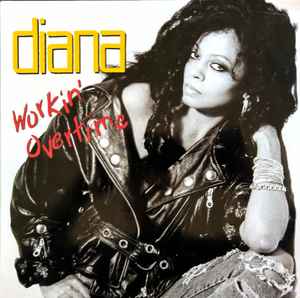chevron_left
-
play_arrow
Italo – Disco italo & HiNRG
-
 play_arrow
play_arrow
2021-12-16 Mixmeister82 By Paul van Delft Paul van Delft
-
 play_arrow
play_arrow
Summer session podcast Robot Heart
- home Home
- keyboard_arrow_right Coverstory
- keyboard_arrow_right Disco Dance Magazine
- keyboard_arrow_right Posts
- keyboard_arrow_rightDisco Dance6, 1989 Coverstory Diana Ross
share
close

Miss Motown is Back
Diana Ross Makes Overtime
You could almost call her the Elvis Presley of female singers. “Working Overtime” is her 55th album, and after an endless string of number one hits as a third of the Supremes and as a solo artist, she is now – after a brief period of rest – ready for a new hit and a renewed acquaintance with this living legend… Diana Ross.
Diana Ross was born on March 26, 1944 (so she is 45 years old) in one of the ghetto neighborhoods of Detroit. At a young age, she formed the Primettes with her neighbors, Florence Ballard and Barbara Martin. They were the sister group of The Primes, also from the Brewster Housing Project in Detroit, who later became known as The Temptations. The Primettes were already frequent visitors to Berry Gordy’s Motown as toddlers. When they completed their high school education, they signed a contract with him. Barbara Martin was replaced by Mary Wilson, and their first single “When the Lovelight Starts Shining Through His Eyes” became a local hit under their new name, The Supremes. They were then connected to the songwriting trio Holland-Dozier-Holland, and the hit machine immediately went into high gear. “Where Did Our Love Go,” “Baby Love,” and “Stop! In the Name of Love” – who doesn’t know these big hits.
Solo
In December 1969, Diana, on the advice of Motown boss Berry Gordy, leaves the Supremes to pursue a solo career. With the help of Ashford & Simpson (“Solid”), she immediately succeeds as a solo artist. Million sellers like “Ain’t No Mountain High Enough” and “Reach Out and Touch” establish her name. In 1973, she adds a new dimension to her already gigantic star status. She plays the lead role in the film “Lady Sings the Blues” and casually receives an Oscar for it. Several hits follow, and films like “Mahogany” and “The Wizard of Oz” also don’t go unnoticed. In 1981, she concludes a very fruitful period at Motown with “Endless Love,” a duet with Lionel Richie. EMI is then the next company where she will try her luck. “Why Do Fools Fall in Love” is her debut on this label, followed by “Silk Electric,” two less successful albums from which only two hit singles “Why Do Fools…” and “Muscles” (with Michael J.) emerged. “Swept Away” would cause a sensation in 1984 with the massive hit “Missing You,” a tribute to Marvin Gaye. The collaboration with the Bee Gees on “Eaten Alive” in 1985 and “Dirty Looks” in 1987 would not bring the desired positive outcome.

House and beyond, with not only the excellent vocals but also swinging like a train (will this be the 2nd single?). The tracks “Going Through the Motions” and “Say We Can” give you
The album contains a total of 10 tracks, with almost no ballads. The aforementioned “This House” is the only ballad, and it stands
Back from hiatus
1989 will undoubtedly be a promising year for Diana Ross. After nearly 2 years of rest, during which she remarried and became a mother again, she has gained many ideas. She has taken the time to listen to what today’s kids like in the discos of London and New York. She has also listened to the leading radio stations and concluded that the youth of then and now still mirror themselves in music.
Children today grow up in a tough society, and music not only expresses their pain and struggle but also finding pleasure in dancing and explosions of sound. Hip-hop, rap, and house support those feelings, and Diana says she has translated that in her own way. Diana Ross has returned to her roots, starting as a background singer with the Supremes, she is now back as one of the directors at this company Motown. (This means that her album “Working Overtime” will be released on Motown Records in America and Canada and through EMI in the rest of the world). She says her return gives her the opportunity to pass on the knowledge she has gained to young artists. She also believes that her faith in Motown has been reaffirmed, which is why the ballad “This House” from her new album is also a kind of ode to her first love.

The album and 12″
Her first 12″ “Working Overtime” from the eponymous album was released on April 24th. The track is written and produced by Nile “Chic” Rodgers, who also took care of the entire album. Nothing is left to chance for the 12″ mixes either. Diana has hired Timmy Regisford for the remixes and house specialists Blaze for the extra overdubs. The 12″ has, in addition to the 7″ version, an extended mix and a house mix, which shines especially because of the beautiful piano solo (Blaze??).
Indeed, it stands like a house. The album also contains 2 tracks that, besides having fairly profound lyrics, have been given a personal touch, namely “What Can One Person Do” and “Take the Bitter with the Sweet.” The latter also stands out for its use of James Brown beats. “Progressive R&B is the word,” they say in America today, meaning the use of hard hip-hop beats under normal singing (think Bobby Brown, for example).
Diana Ross already demonstrates this in the hit single “Working Overtime,” but “Bottom Line” and “Keep On” also reflect her explanation. The big standout on the album is without a doubt the first track on side 2, called “Paradise,” which almost feels like being back in her Supremes period. Last but not least, “We Can Stand Together” should be mentioned. In my opinion, the weakest of the album, but many artists would be happy to record such a song.
Overall, an album that undoubtedly puts Diana Ross back on the pedestal where she belongs.
Finally, there is the grand world tour, with the Netherlands being one of the first to be visited last month.
As a preview, she did a surprise performance in London on April 20th at a party next to Soul II Soul, Aswad, Adeva, and Kym Mazelle, and the roof went off the venue.
Disco Dance6, 1989 by Rob Boskamp
Written by: Andy
1989 coverstory diana ross disco dance rob boskamp
Rate it






-100x100.jpg)



Post comments (0)